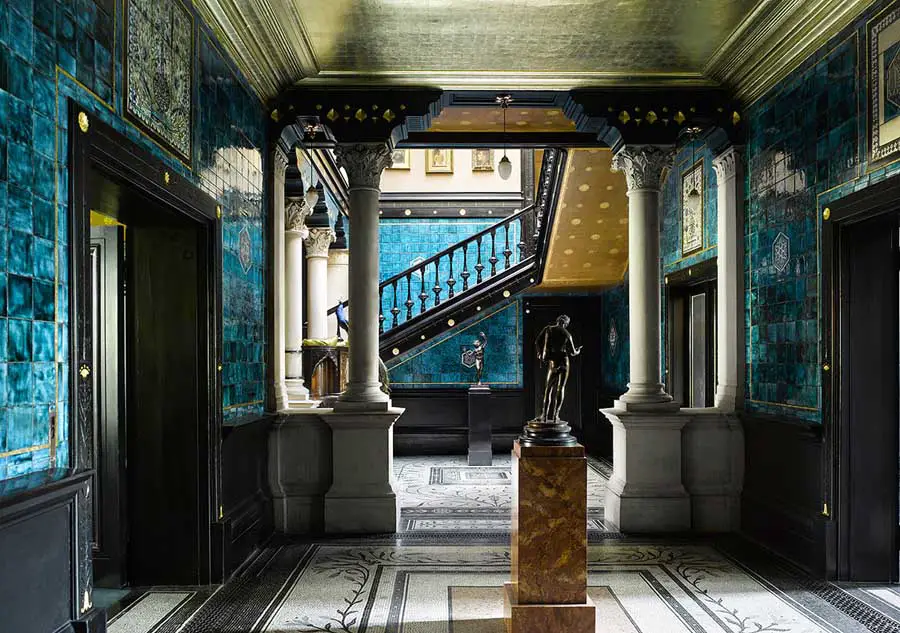Dante Gabriel Rossetti “Proserpine” 1874

While walking around the Tate Britain, especially in the 1840’s room, there were many paintings which caught my eye for one reason or another, but the painting “Proserpine” by Dante Gabriel Rossetti from 1874 was the one that stuck in my head despite moving on to many other fantastic paintings, so I had to return and study this mesmerizing painting. The most striking aspect of this painting is the face of the figure in the painting. It is very obviously female, being based upon the Roman deity Proserpina, who was female, yet there are very traditionally masculine features in the jawline and the hands giving a very androgynous feel to the figure, though still feminine.
The figure is holding a pomegranate with a bite taken out of it. This pomegranate is yellow instead of the typical red color we see today, though that could be from the time it would take for a pomegranate to travel to England in that time, becoming overripe. Knowing the pomegranate is the fruit that caused Proserpina to be forced to go to the underworld after eating it starts to unfold the meaning behind the small details within the painting. Knowing the mythology adds the information that Proserpina is only able to return to her mother once a year, which is when spring happens, as indicated by the flora in the background and the pleasant light on the face of the figure. However, the dish at the bottom seems to be empty, and the pomegranate is unripe, contrary to the idea of spring and prosperity.
Looking closely at the figure’s face, I noticed she had a peculiar expression, kind of a mix of disappointment, anger, and boredom. Judging off of the same mythology, we can assume that it may be nearing the end of spring since there is nothing on the dish, the sun is full in the sky like summer, and the fruit is overripe. This means that Proserpina is with her mother, yet not for much longer. Though this should be her happiest time of year, instead of rejoicing in her freedom, as short as it is, she seems to instead be thinking of the future and the past instead of the present, something she would regret in the future during her time stuck in the underworld. Most of the body is covered by a shapeless blue-green cloth. The only other direct visual feature of the figures body is in the hands, where one is holding the pomegranate, and the other seems to almost be holding the pomegranate-holding hand back, a nod towards the mythology once again in the pomegranate being the fruit of the underworld.
For the time of the Pre-Raphaelites, which many of their works were viewed extremely negatively, the “Proserpina” may also have been seen in a negative light for some of the issues brought up within the painting. Taking this painting within the context of imperialism, the lore surrounding Proserpine and being torn away from her home to be forced to live in another, unfamiliar place is one view of imperialism, and a very negative one, definitely one that would clash with the common views on imperialism at the time based upon how much was taken from various countries without the consent of the original cultures. The Elgin Marbles is a good example of this. Additionally, the androgyny of the figure and the undertones of evilness/darkness within the very spring-like atmosphere brings up a contradictory tone which may be upsetting and unsettling to those within the Victorian age.
A major idea around the Pre-Raphaelites is the utility along with the beauty of art, which a painting may not prove to have a direct utility aspect, but that idea of that aspect is within the painting itself, the figure and objects within the painting are incredibly detailed, yet very simple at the same time. All the figure wears is a simple robe, the wall in the background is bare, the table is plain wood, and except for a single dish, there is nothing on the table. It looks like a simple country home instead of an aristocratic stately home. Everything is beautiful within the painting, but everything has a definite purpose and is not full of any more frills than it needs. This simple yet intricate combination within the painting seems to advocate the usefulness of art within one’s life since it displays a scene even a lower-class citizen would see, not a grand staircase or sitting-room or the like. Looking from a perspective today, this simplicity, along with the mythological aspects, spans to the entire social web of classes and has that relatability such that anyone would be extremely proud to be able to show this off within their home. This aspect of art ebbs on the side of art as useful instead of useless and having no purpose within anyone’s life.




















